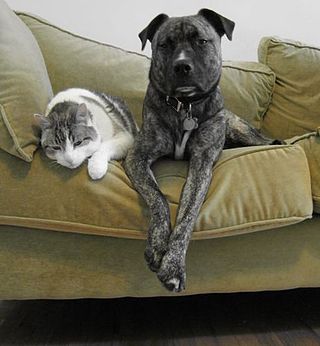
A pet, or companion animal, is an animal kept primarily for a person's company or entertainment rather than as a working animal, livestock, or a laboratory animal. Popular pets are often considered to have attractive/cute appearances, intelligence, and relatable personalities, but some pets may be taken in on an altruistic basis and accepted by the owner regardless of these characteristics.

A paw is the soft foot-like part of a mammal, generally a quadruped, that has claws.

Bordetella bronchiseptica is a small, gram-negative, rod-shaped bacterium of the genus Bordetella. It can cause infectious bronchitis in dogs and other animals, but rarely infects humans. Closely related to B. pertussis—the obligate human pathogen that causes pertussis ; B. bronchiseptica can persist in the environment for extended periods.
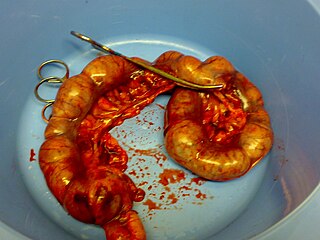
Pyometra or pyometritis is a uterine infection. Though it is most commonly known as a disease of the unaltered female dog, it is also a notable human disease. It is also seen in female cattle, horses, goats, sheep, swine, cats, rabbits, hamsters, ferrets, rats and guinea pigs. Pyometra is an important disease to be aware of for any dog or cat owner because of the sudden nature of the disease and the deadly consequences if left untreated. It has been compared to acute appendicitis in humans, because both are essentially empyemas within an abdominal organ.

A dewclaw is a digit – vestigial in some animals – on the foot of many mammals, birds, and reptiles. It commonly grows higher on the leg than the rest of the foot, such that in digitigrade or unguligrade species, it does not make contact with the ground when the animal is standing. The name refers to the dewclaw's alleged tendency to brush dew away from grass. On dogs and cats, the dewclaws are on the inside of the front legs, similarly to a human's thumb, which shares evolutionary homology. Although many animals have dewclaws, other similar species do not, such as horses, giraffes and the African wild dog.

Onychectomy, popularly known as declawing, is an operation to remove an animal's claws surgically by means of the amputation of all or part of the distal phalanges, or end bones, of the animal's toes. Because the claw develops from germinal tissue within the third phalanx, amputation of the bone is necessary to fully remove the claw. The terms onychectomy and declawing imply mere claw removal, but a more appropriate description would be phalangectomy, excision of toe bone.
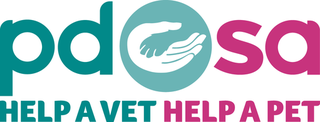
The People's Dispensary for Sick Animals (PDSA) is a veterinary charity in the United Kingdom. It was founded in 1917 by Maria Dickin to provide care for sick and injured animals of the poor. It is the UK's leading veterinary charity, carrying out more than one million free veterinary consultations a year, and was until 2009 the largest private employer of fully qualified veterinary surgeons and veterinary nurses in the UK; only those living within the PDSA's catchment areas can use their services.
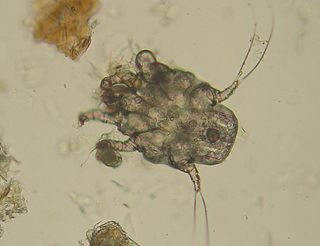
Ear mites are mites that live in the ears of animals and humans. The most commonly seen species in veterinary medicine is Otodectes cynotis. This species, despite its name, is also responsible for 90% of ear mite infections in felines.
Pneumonia is an irritation of the lungs caused by different sources. It is characterized by an inflammation of the deep lung tissues and the bronchi. Pneumonia can be acute or chronic. This life-threatening illness is more common in cats than in dogs and the complication “Kennel Cough” can occur in young pets.
Littlest Pet Shop is a toy franchise and cartoon series owned by Hasbro and currently under license with Basic Fun!. The original toy series was produced by Kenner in the early 1990s. An animated television series was made in 1995 by Sunbow Productions and Jean Chalopin Creativite et Developpement, based on the franchise.

Cheyletiella is a genus of mites that live on the skin surface of dogs, cats, and rabbits.

Veterinary surgery is surgery performed on non-human animals by veterinarians, whereby the procedures fall into three broad categories: orthopaedics, soft tissue surgery, and neurosurgery. Advanced surgical procedures such as joint replacement, fracture repair, stabilization of cranial cruciate ligament deficiency, oncologic (cancer) surgery, herniated disc treatment, complicated gastrointestinal or urogenital procedures, kidney transplant, skin grafts, complicated wound management, and minimally invasive procedures are performed by veterinary surgeons. Most general practice veterinarians perform routine surgeries such as neuters and minor mass excisions; some also perform additional procedures.
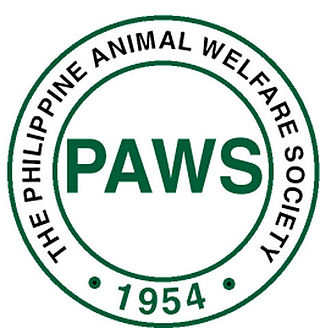
The Philippine Animal Welfare Society (PAWS) is a volunteer-based, non-government organization whose goal is to prevent animal cruelty through education, animal sheltering and advocacy, based in Quezon City, Philippines. It was founded in 1954 by Muriel Jay. PAWS believes that the creation of a more peaceful society starts with the widening of mankind's circle of compassion which includes animals, thereby envisions a nation that respects animals, practices responsible pet ownership and protects wildlife. The volunteer-based organization rehabilitates these animals in the hope of finding them new homes and a second chance at a good life. PAWS does not take in pets of other people, but only victims of cruelty or neglect where the animal offenders are charged with violation of the Animal Welfare Act in court.

Veterinary chiropractic, also known as animal chiropractic, is chiropractic for animals – a type of spinal manipulation. Veterinary chiropractors typically treat horses, racing greyhounds, and pets. Veterinary chiropractic is a controversial method due to a lack of evidence as to the efficacy of chiropractic methods. Contrary to traditional medicine, chiropractic therapies are alternative medicine. There is some degree of risk associated with even skilled manipulation in animals as the potential for injury exists with any technique used. The founder of chiropractic, Daniel David Palmer, used the method on animals, partly to challenge claims that the placebo effect was responsible for favorable results in humans. Chiropractic treatment of large animals dates back to the early 1900s. As of 2019, many states in the US provide statutory or regulatory guidelines for the practice of chiropractic and related treatments on animals, generally requiring some form of veterinary involvement.

Bob Martin Petcare is a British domestic pet healthcare company. The company manufactures across two sites in the United Kingdom, and is based in Yatton in North Somerset. The company also has offices in Germany, Italy, France and Spain and two manufacturing sites in South Africa.
The National Office of Animal Health (NOAH) is a British organisation that represents the voice of its members from within the animal medicine industry in the United Kingdom of Great Britain and Northern Ireland.

Human interaction with cats relates to the hundreds of millions of cats that are kept as pets around the world. The inter-relationship involves companionship, communication and caregiving. Dating back thousands of years, cats were originally domesticated for their ability to control pests and later became valued companions. Cats communicate through vocalizations, body language and behaviors, forming strong bonds with their human owners. Owners provide the food, shelter, and medical care, while play and enrichment activities stimulate their physical and mental well-being. Despite their independent nature, cats enjoy human company and require understanding of their unique behaviours. Positive reinforcement training can shape desired behaviours, fostering a harmonious relationship between humans and their feline companions, built on mutual respect and affection.

Assisi Animal Sanctuary in Conlig, County Down is Northern Ireland's largest independent animal welfare charity. It shelters up to 200 companion animals at any given time. These have included dogs, puppies, cats, kittens, rabbits and guinea pigs. Several hamsters are permanent residents, and have been included in the center's animal welfare education program.
30 millions d'amis is a French television program, a French monthly magazine with its posters, and a French foundation: the Fondation 30 Millions d'Amis. All three focus on pets, especially cats, dogs, horses, ferrets, rabbits, guinea pigs, rats, hamsters, mice, canaries, parakeets, parrots, terrarium reptiles, goldfish, aquarium fish, and other exotic pets, but also wild animals like for example, bonobos and cheetahs.














